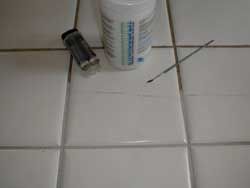Ceramic Tile Crack Prevention
DEAR TIM: Cracks are beginning to appear in the floors of our three-month old new home. The tile was laid directly on the concrete slabs that make up the sub-floor of my home. The day after the slabs were poured the concrete block walls were erected. Could this be the cause of the cracks? What could have been done to prevent the cracks? Do the tiles have to be taken up and replaced or is there another solution? John D. Hallandale, FL
DEAR JOHN: Tile loves to be installed over concrete because concrete is such a hard, durable substrate. But concrete does have an Achilles' heel - not only does concrete crack, it wants to crack. As concrete makes the transformation from the liquid state to a rock-hard material, it shrinks ever so slightly. In fact, concrete slabs can shrink 1/16th of an inch for every ten linear feet of distance. This shrinkage creates a significant tension force within the slab.

This tile is cracked. It is a very fine crack, but should be filled with clear epoxy before repainting begins.
The concrete slab cracking process is very similar to what happens prior to and during an earthquake. As the plates of the earth move, they often get wedged against one another. This stored force is relieved naturally the by-product being a violent earthquake. Similar forces build within the freshly poured concrete slab. As soon as they exceed the strength of the concrete, the slab pops and cracks. Cracks can appear within hours of the concrete pour, but typically you begin to see them within 30 days. I doubt the block laying activity caused the cracks. In all likelihood, they would have happened with or without the concrete blocks.
Ceramic tile is a dense building product just like concrete. Both materials are very strong when you compress them, but they typically only have one tenth the strength when tension forces successfully pull them apart. To make matters worse, cracks that happen in the slab below ceramic tile will often telegraph through the tile because the organic or cement based adhesives make the tile and concrete one monolithic material.
You can prevent cracks in ceramic tile that is laid over concrete in any number of ways. The first thing to do is add steel and fibers to the concrete slab. While these materials will not insure a crack-free slab, they will hold the concrete together such that small harmless hairline cracks occur instead of cracks in excess of 1/8 inch or more. Quality builders will place inexpensive one half inch diameter steel reinforcing bars in the middle of the concrete slab. These bars should be placed in a grid pattern with the bars on two foot centers in both directions. The bars must be supported during the pour so that they end up in the center of the concrete. In addition, the concrete can be ordered with special fibers that will help prevent shrinkage and tension cracks.
The ceramic tile installer could have also installed crack isolation membranes under the tile. These membranes are available as a liquid coating that is applied over the concrete slab or an actual synthetic fiber fabric. They allow the concrete floor below to move independently of the tile that is laid just above. The membranes work well if there is slight cracking but will not prevent cracks in tile should there be significant structural movement caused by a foundation, soil, or construction defect. These membranes are often sold at ceramic tile specialty stores that cater to real ceramic tile professionals.
Since your home is still within warranty, I would write a letter to the builder informing him of the defect. Hopefully, you have extra tiles left over that are from the same run or batch. If not, try to get some matching replacement tiles immediately. Purchase matching tile grout at the same time. I would wait another six months or so before I would initiate the repair. Additional cracks may appear between now and then and all broken tiles can be replaced at one time. If the grout gets dirty before the repair, it should be cleaned just before the workmen arrive. Doing this will insure that the new grout will match the existing grout perfectly. Dirty colored or white floor tile grout can be successfully cleaned with a solution of oxygen bleach.
Existing floor tile cracks can be patched with clear epoxies. Apply the epoxy carefully and add additional epoxy until the dried epoxy is flush with the tile surface. Using a fine artist's brush, apply oil based paint that matches the color of the tile to the epoxy. Once this dries, use the same brush to apply three coats of clear water-based urethane over the repaired crack. This urethane will protect the paint for several years. Apply additional maintenance coats of urethane every two years.
| Message from Tim:
Years ago while researching a column about cleaning decks, I discovered the wonders of Oxygen Bleach. It is perhaps the 'greenest' cleaner I know of as it uses oxygen ions to break apart stains, dirt and odor molecules. There are no harsh chemicals, and it works on just about anything that is water washable. I decided to create my own special blend using ingredients made in the USA. In fact, the raw materials in the active ingredient are food-grade quality registered with the FDA. I call my product Stain Solver. I urge you to use it to help with cleaning your ceramic tile grout. You will be amazed at the results! |
Column 424